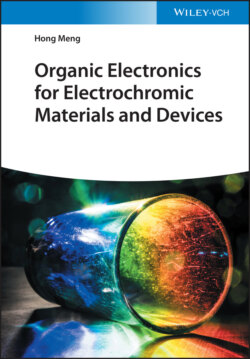Читать книгу Organic Electronics for Electrochromic Materials and Devices - Hong Meng - Страница 26
2.3.1.2 PMMA‐Based Polymer Electrolytes
ОглавлениеDue to high degree of crystallization, low ionic conductivity at ambient temperature exists in PEO‐based PE [43]. PMMA along with PVDF PEs have recently caused great attention in EC application. PMMA including amorphous phase and flexible backbone could increase ionic conductivity. As was reported, PMMA can provide a high transparency, excellent environmental stability, good gelatinizing properties, high solvent retention ability, and excellent compatibility with the liquid electrolytes [44, 45]. Moreover, PMMA shows good interfacial stability toward electrodes and high solvation ability to form complexation between polymer and salt. Highly ionic conductive PMMA exists as a gel and is mainly used for electrochromism [45]. Anderson et al. majored on ECDs with films of W oxide and vanadium pentoxide and an intervening layer of a PPG–PMMA–LiClO4 [46, 47]. Reynold and coworkers first reported a polymeric ECD using poly(3,4‐proplenedioxythiophene) (PProDOTMe2) and poly[3,6‐bis(2‐(3,4‐ethylenedioxy)‐thienyl)‐N‐methylcarbazole] (PBEDOT‐N‐MeCz) as the cathodically and anodically coloring polymers, respectively [48]. In this device, the EC films were electrosynthesized in poly (3,4‐ethylenedioxythiophene) (PEDOT)‐PSS electrodes at the oxidation potential of the monomer, and the electrolytes were prepared by using PMMA as the novel polymer matrix. The GPE having composition of 70 : 20 : 7 : 3 (ACN: PC: PMMA: TBAPF6 [tetrabutylammonium hexafluorophosphate]) was applied in the ECDs [48]. For the durability of the device, GPE was evaporated at the edges during the sealing process. The ECD exhibited a large transmittance change (Δ%T) of 51% at the wavelength of 540 nm and only 5% contrast loss after 32 000 switches. Beaupre et al. reported a flexible EC cell by using PMMA‐LiClO4 electrolyte, which was plasticized with propylene carbonate to form a highly transparent and conductive gel. Sonmez et al. has explored a highly transparent and conductive gel with LiClO4 plasticized with PC, having composition of PC: PMMA (MW: 350.000): LiClO4 (70 : 20 : 7 : 3), which was applied in EC device [49]. ACN was also added as a high vapor pressure solvent to make the gel ingredients blend easily. Oral et al. uses similar electrolyte of LiClO4: ACN: PMMA: PC in the ratio of 3 : 70 : 7 : 20 to study the EC properties [49]. Tung et al. studied the EC properties of the device of PEDOT‐Prussian Blue (PB) using PMMA as GPE [50]. The device exhibited high coloration efficiency and good long‐term cycling stability. Recently, Yang et al. studied a new type of GPE composed of free‐standing aramid nanofibers, which was used to fabricate all‐solid‐state near‐infrared (NIR) ECDs for NIR sheltering applications [51]. This new type of GPE showed excellent mechanical and heat endurance compared with currently available GPEs. Kim et al. presented a novel ECD‐based photonic device, which can modulate IR light intensity in a planar optical waveguide ECD by using PMMA gel electrolyte consisting of 5% (w/w) PMMA, 4% (w/w) phenothiazine, 0.1 m LiClO4, and 11.25 ≈ 10−3 m ferrocene [52]. The results confirm a new approach to consider ECD‐based optical modulators for the development of planar photonic‐integrated circuits and systems.
